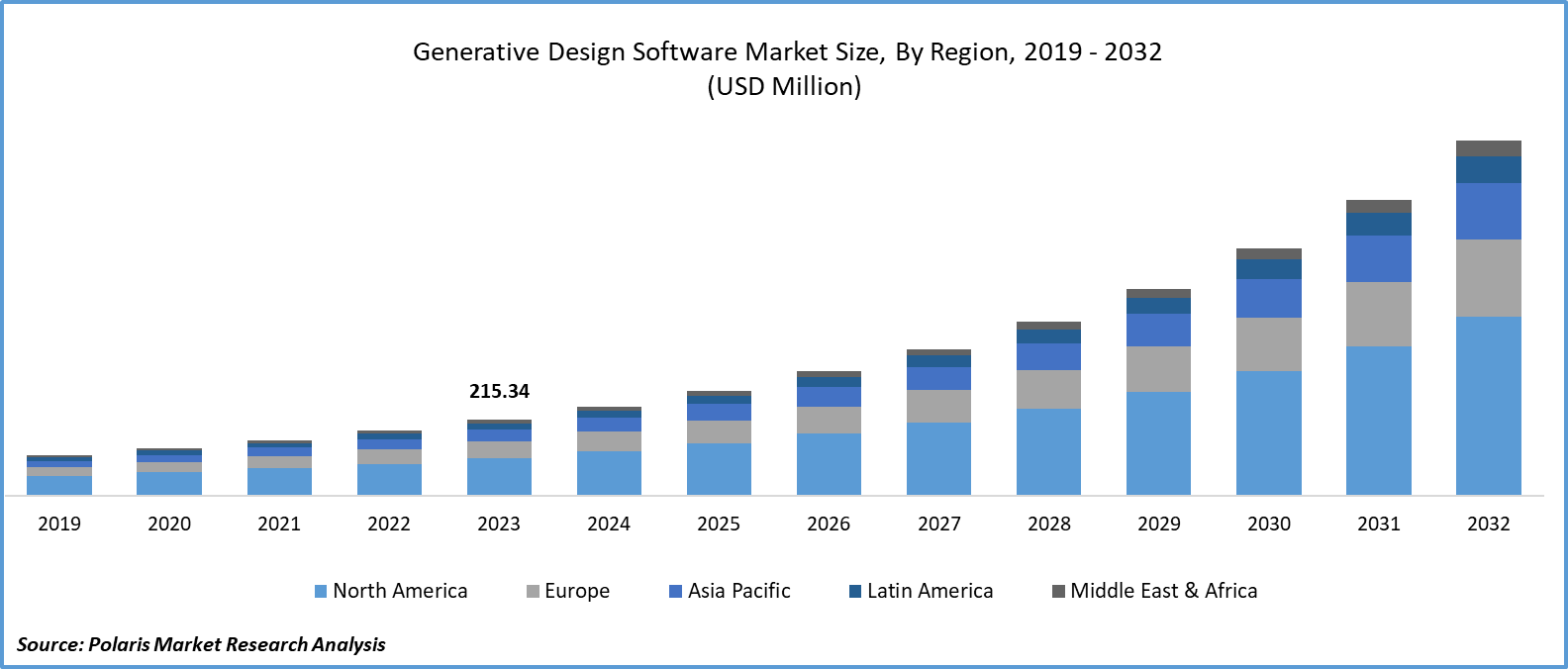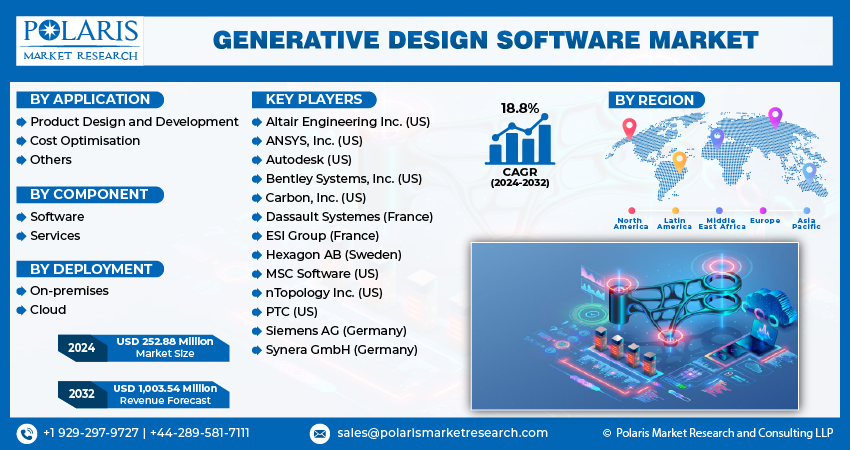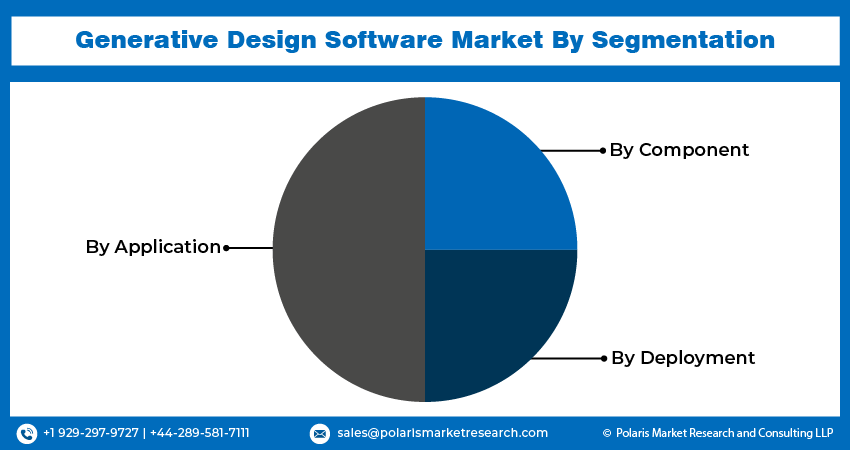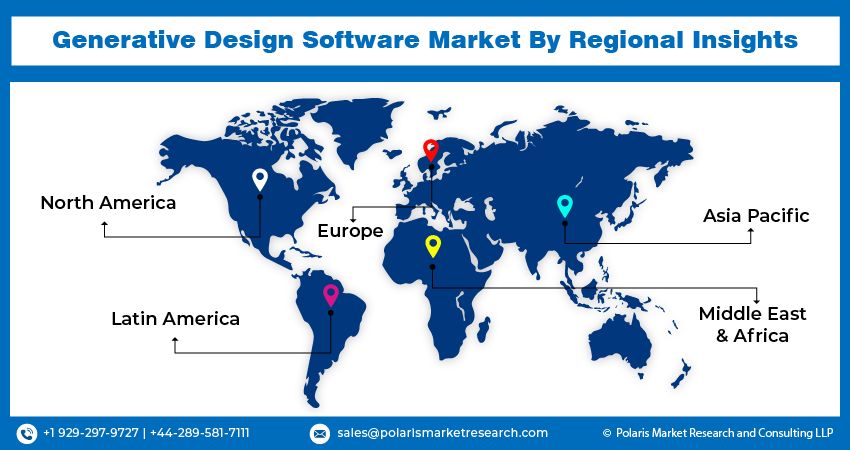
Generative Design Software Market Share, Size, Trends, Industry Analysis Report
By Application (Product Design and Development, Cost Optimization, and Others); By Component; By Deployment; By Region; Segment Forecast, 2024- 2032
- Published Date:Mar-2024
- Pages: 116
- Format: PDF
- Report ID: PM4680
- Base Year: 2023
- Historical Data: 2019 – 2022
Report Outlook
Global generative design software market size was valued at USD 215.34 million in 2023. The market is anticipated to grow from USD 252.88 million in 2024 to USD 1,003.54 million by 2032, exhibiting the CAGR of 18.8% during the forecast period.
Market Overview
The rising demand and proliferation of novel design software from various industries, including aerospace, automotive, and manufacturing, to optimize their designs for better performance, sustainability, and cost-effectiveness are driving the market’s growth. Companies increasingly investing in R&D activities to foster the development of new software tools with enhanced capabilities and features, the market for generative design software will likely have a positive impact.
For instance, in May 2023, Encora introduced its newly developed Generative AI technology that offers increased productivity, better market fit for businesses, and higher-quality software. The newly launched software brings capabilities to deliver efficiencies across core software engineering, quality engineering, and UI design.

To Understand More About this Research:Request a Free Sample Report
Furthermore, generative design is transforming the traditional development processes by automating several manual coordination steps. In place of manually designing the components, generative design allows engineers to describe their properties mathematically based on artificial intelligence algorithms that eliminate the need for manual tasks and long waiting times and streamline the overall development process.
Growth Factors
Rapid Advancements in AI and Computational Power Technologies to Drive Market Growth
Due to the rapid advent of technologies such as artificial intelligence and machine learning, companies are surveying to leverage these algorithms to optimize their design performances and analyse vast datasets. Also, the rising proliferation of computer-aided design (CAD) worldwide enables for the faster optimization of designs, further driving the adoption of generative design software
For instance, in November 2023, PassiveLogic launched its new platform for generative AI that empowers individuals to design as well as implement their autonomous system with the help of Quantum Standard. It includes Quantum Lens, which is a generative design app designed to make it easy to scan or survey new projects.
Rising Awareness of Sustainability Driving the Adoption
As sustainability concerns are rising across the globe and consumers are becoming more aware of the importance of technology, businesses are looking for generative design software. It will help companies to develop environmentally friendly design solutions resulting in reduced energy consumption and less material usage. Thereby, generative design software allows companies to align with sustainability goals and standards, gaining huge traction and demand.
For instance, in February 2022, Digital Blue Foam, which is a sustainable web-based generative design tool, was launched. This tool is specially made for architects, educators, planners, and developers who bring together AI, software, and data to make sustainable building design more accessible.
Restraining Factors
Complexity of Generative Design Software to Hamper Market Growth
Generative design software is often complex to use and requires significant training and expertise to utilize effectively; thereby, it creates a barrier for small companies to use such tools due to a lack of specialized professionals and limited resources.

Report Segmentation
The market is primarily segmented based on application, component, deployment, and region.
|
By Application |
By Component |
By Deployment |
By Region |
|
|
|
|
To Understand the Scope of this Report:Speak to Analyst
By Application Insights
Product Design and Development Segment Accounted for the Largest Share in 2023
The product design and development segment accounted for the largest market share. This dominance is attributed to its significant adoption and use by engineers and architects all over the world due to its ability to provide thousands of design suggestions within a few minutes or seconds. It allows designers and engineers to easily filter the provided suggestions and opt for the best outcome suited for their application and use.
In addition, with the help of generative design, product design & development can be easily tailored to individual or specific requirements and preferences that result in its application across numerous industries with different application requirements.
By Component Insights
Software Segment is Expected to Hold a Significant Market Share
The software segment is expected to hold a substantial market share. The key reason for market demand is the surging need for advanced software solutions that automatically create optimum forms or products and help designers to reduce working hours on various manual designing tasks. In addition, the rapid advancements in AI and machine learning led to improved capabilities and features of generative design software and allowed them to perform various complex and difficult tasks.
By Deployment Insights
On-premises Segment led the Market in 2023
The on-premises segment led the market revenue in 2023. Segment’s dominance is fueled by its widespread adoption by large enterprises due to its ability to offer greater control over the data, reduce concerns related to data breaches, and ensure better compliance with industry standards. Additionally, on-premise solutions have several beneficial characteristics, such as customization & integration, better connectivity, reliability, faster processing, and cost-efficiency, which all contribute to the demand across several industries.
The cloud segment is expected to grow at the highest CAGR during the forecast period. This growth is attributable to an increased preference for cloud-based solutions over other types due to their accessibility, high performance, scalability, and cost-effectiveness. These solutions can also be integrated with other cloud-based services that help to streamline workflows and enhance overall productivity.

Regional Insights
North America Region Dominated the Global Market in 2023
The North American region dominated the global market. The region’s dominance is attributed to the robust presence of well-established industry verticals and significant investments in cutting-edge technologies, including generative design. In addition, greater demand for efficient storage solutions and industrial automation, coupled with the rising focus on minimizing infrastructure cost, particularly in developed countries, driving the market. For instance, in January 2024, Poliark announced the launch of its subscription-based product called ‘Kend’. This is built in generative AI technology and is designed for engineers and architects.
The Asia Pacific region is anticipated to emerge as the fastest-growing region. The growth is attributed to the surging adoption of generative design solutions across industries and the growing evolution of Industry 4.0 in the region, creating room for advanced technologies, including generative design. Increasing urbanization and infrastructure development in emerging economies such as India, China, and other Southeast Asian countries fosters the demand for software among architects, urban planners, and engineers to design complex structures efficiently. For instance, according to a report by The Hindu, India’s urban population is projected to reach 675 million by 2035, increasing from an estimated 483 million in 2020. Therefore, owing to the rising demand for habitation, there will be a demand for generative software for better planning and utilization of living space.

Key Market Players & Competitive Insights
Strategic partnerships to drive the competition
The generative design software market is highly competitive in nature with the robust presence of global market players. The key players are competing on various factors such as improving their performance & speed, enhancing features, and integration with other design tools. Also, companies are extensively focusing on various business development strategies including partnerships, collaborations, acquisitions, and new software launches, to expand their market reach and product offerings.
Some of the major players operating in the global market include:
- Altair Engineering Inc. (US)
- ANSYS, Inc. (US)
- Autodesk (US)
- Bentley Systems, Inc. (US)
- Carbon, Inc. (US)
- Dassault Systemes (France)
- ESI Group (France)
- Hexagon AB (Sweden)
- MSC Software (US)
- nTopology Inc. (US)
- PTC (US)
- Siemens AG (Germany)
- Synera GmbH (Germany)
Recent Developments in the Industry
- Cadence Design Systems has launched Cadence Voltus InsightAI, marking a significant milestone in AI technology. It pioneers generative AI capabilities to autonomously pinpoint the underlying triggers of EM-IR during the design phase. This innovative solution empowers engineers with heightened efficiency, enabling them to swiftly detect and address issues while providing a range of productivity-boosting functionalities.
- In October 2023, Adobe announced diverse new generative AI enhancements in its core product lines. The company launched three different AI models, improved features for Illustrator Adobe Express, and enhanced text-to-image capabilities.
Report Coverage
The generative design software market report emphasizes on key regions across the globe to provide better understanding of the product to the users. Also, the report provides market insights into recent developments, trends and analyzes the technologies that are gaining traction around the globe. Furthermore, the report covers in-depth qualitative analysis pertaining to various paradigm shifts associated with the transformation of these solutions.
The report provides detailed analysis of the market while focusing on various key aspects such as competitive analysis, application, component, deployment, and their futuristic growth opportunities.
Generative Design Software Market Report Scope
|
Report Attributes |
Details |
|
Market size value in 2024 |
USD 252.88 million |
|
Revenue forecast in 2032 |
USD 1,003.54 million |
|
CAGR |
18.8% from 2024 – 2032 |
|
Base year |
2023 |
|
Historical data |
2019 – 2022 |
|
Forecast period |
2024 – 2032 |
|
Quantitative units |
Revenue in USD million and CAGR from 2024 to 2032 |
|
Segments covered |
|
|
Regional scope |
|
|
Competitive Landscape |
|
|
Report Format |
|
|
Customization |
Report customization as per your requirements with respect to countries, region, and segmentation. |
FAQ's
The Generative Design Software Market report covering key segments are application, component, deployment, and region.
Generative Design Software Market Size Worth $1,003.54 Million By 2032
Generative Design Software market exhibiting the CAGR of 18.8% during the forecast period.
North America is leading the global market
key driving factors in Generative Design Software Market are Rising awareness of sustainability driving the adoption
